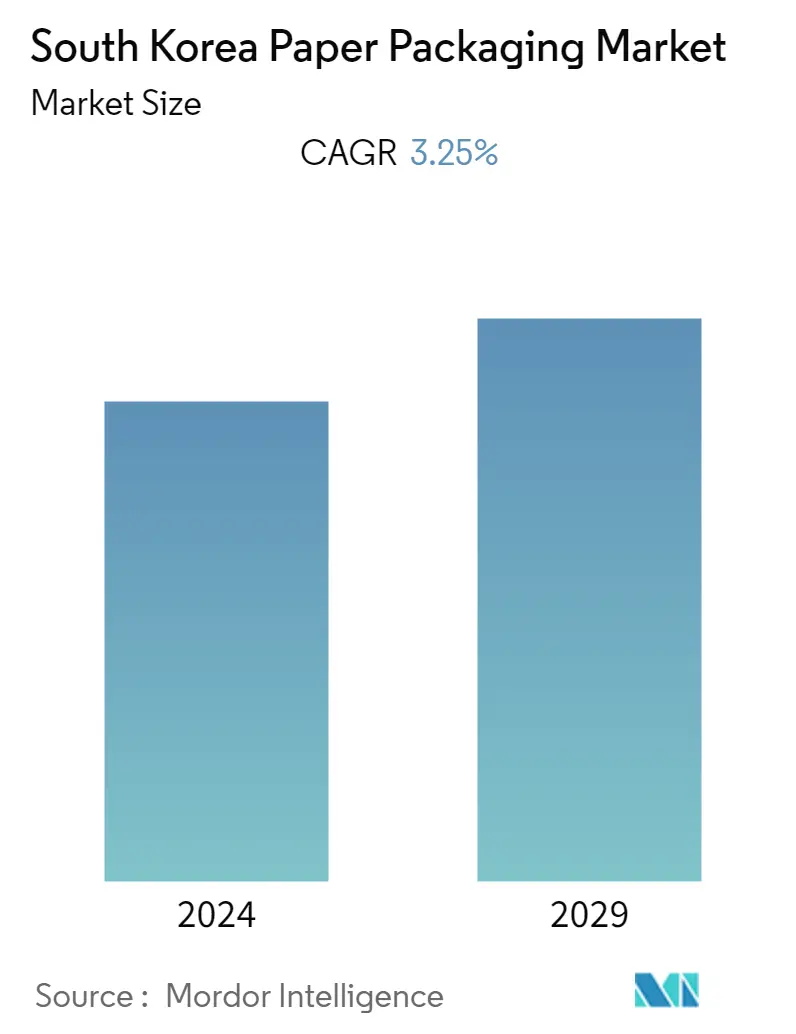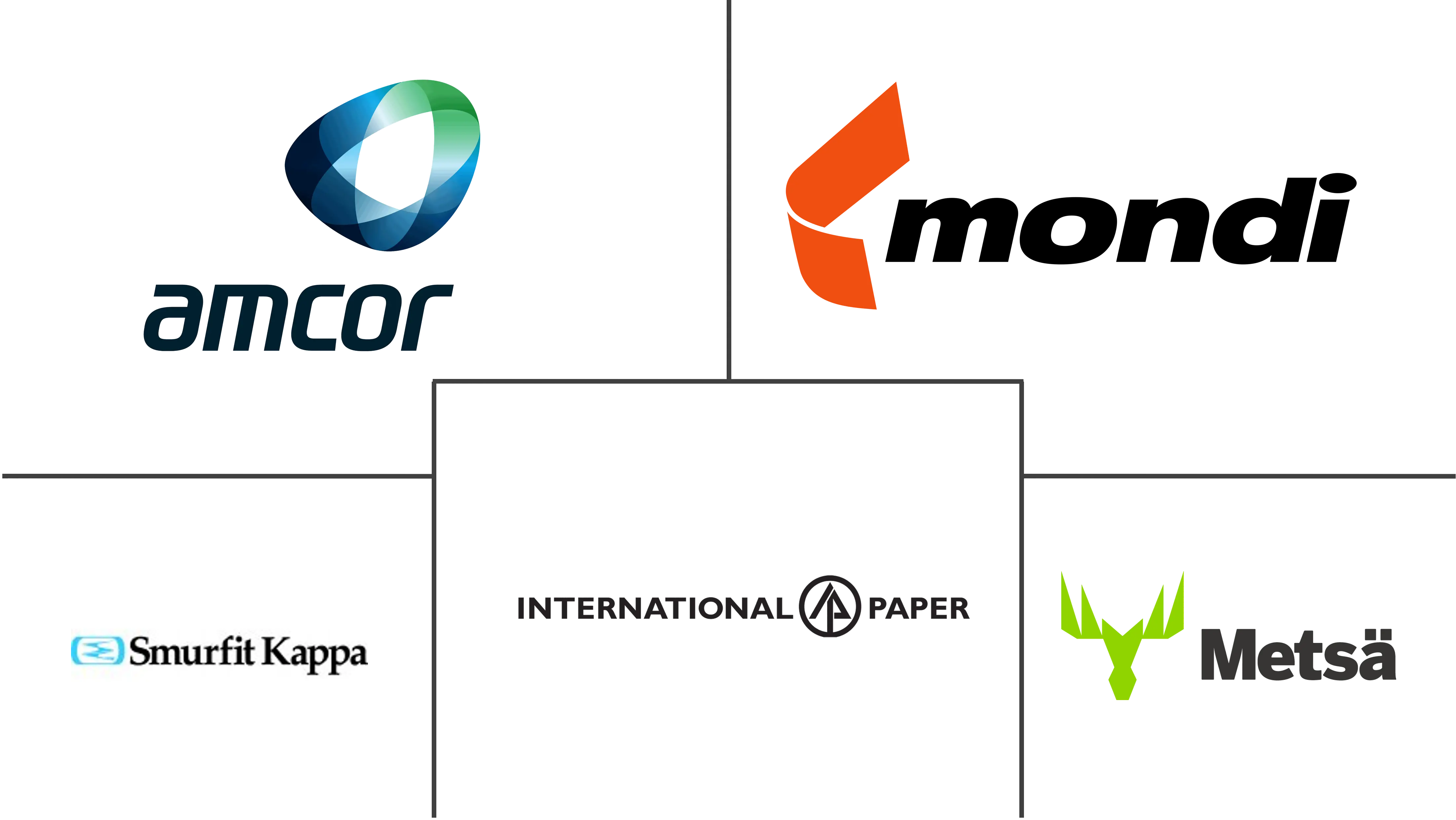Market Size of South Korea Paper Packaging Industry

| Study Period | 2019 - 2029 |
| Base Year For Estimation | 2023 |
| Forecast Data Period | 2024 - 2029 |
| Historical Data Period | 2019 - 2022 |
| CAGR | 3.25 % |
| Market Concentration | Medium |
Major Players
*Disclaimer: Major Players sorted in no particular order |
South Korea Paper Packaging Market Analysis
The South Korean paper packaging market is expected to grow at a CAGR of 3.25% over the forecast period. Food delivery services and expanding e-commerce are anticipated to continue to develop rapidly over the following years, contributing to the market's expansion.
- People in the country are choosing accessible and sustainable packaging options as they become more conscious of the effects that packaging materials have on the environment and, as a result of their busy lifestyles, demand convenience. The need for paper-based packaging supplies is thus anticipated to increase.
- Taking into account of excessive use of single-use plastics, the government of South Korea 2019 imposed a ban on all types of single-use plastics. Therefore, banning all sorts of packaging and wrapping materials, the food and beverage industry that relies heavily on plastic packaging is since then looking for new methods for packaging products that can keep wet food items such as fish and meat safe but can also withstand transportation stress. Moreover, many such products are made of paper and cardboard that the food and restaurant industry can use in the market. With the ban on plastic packaging material, paper packaging can be a suitable alternative to fill the space.
- The rising retail and e-commerce industries and the growing need for environmentally friendly packaging materials are currently driving the market's expansion. Domestic internet purchases in South Korea reached USD 168.5 billion in 2021, up from USD 135.1 billion in 2020, according to the International Trade Administration of the United States Department of Commerce. The need for secondary and tertiary paper packaging products has increased dramatically as online shopping platforms have proliferated.
- Paper, pulp, resins, paperboard, and adhesives are some of the most popular raw materials utilized by paper packaging industries. The prices of these essential materials have risen dramatically in the flexible packaging business in recent years.
- Consumer packaged goods firms are always looking for new methods to meet consumer wants and improve their offers. They frequently rely on paper packaging firms to develop new products and draw more customers to the store shelf. However, participants in the paper packaging business often need help to keep up with these rapidly shifting expectations. Furthermore, to satisfy these needs, paper packaging companies would need to upgrade their equipment regularly, which will necessitate significant capital investments.
- COVID-19 has led to unforeseen supply chain obstructions and order backlogs, resulting in a spike in paper prices. The competitiveness of enterprises in the flexible packaging industry has been harmed due to this predicament. According to a survey by Korea Rural Economic Institute (KREI) 2020, roughly 33.6% of South Korean households bought meal delivery or takeaway every two weeks due to the COVID-19 Pandemic. A similar proportion of households placed weekly food orders. Only 0.1% of those polled said they purchased takeout or had food delivered daily. Furthermore, there is a strong emphasis on hygiene and product protection. There is a growing demand for paper packaging items in South Korea since they are used just once, are sustainable, and can be recycled.
South Korea Paper Packaging Industry Segmentation
The market for the study defines the revenue generated from the sales of paper packaging products, such as folding cartons and corrugated boxes, across various end-user applications considered under the scope. The market tracks the consumption volume and value of paper packaging products in the country. The analysis is based on the market insights captured through secondary research and the primaries. The market also covers the major factors impacting the growth of the South Korean paper packaging market in terms of drivers and restraints.
The South Korean paper packaging market is segmented by product type (folding cartons, corrugated boxes) and end-user industry (food and beverage, healthcare, personal care and household care, and industrial). The market sizes and forecasts are provided in terms of value (USD million) for all the above segments.
| By Product Type | |
| Folding Cartons | |
| Corrugated Boxes | |
| Other Product Types (Flexible Paper Packaging, Liquid Cartons, etc.) |
| By End-user Industry | |
| Food and Beverage | |
| Healthcare | |
| Personal Care and Household Care | |
| Industrial | |
| Other End-user Industries |
South Korea Paper Packaging Market Size Summary
The South Korean paper packaging market is poised for growth, driven by the increasing demand for sustainable and convenient packaging solutions. As consumers become more environmentally conscious and seek convenience in their busy lifestyles, the preference for paper-based packaging is on the rise. The government's ban on single-use plastics has further accelerated this trend, pushing industries, particularly food and beverage, to explore paper and cardboard alternatives that can withstand transportation and preserve product integrity. The burgeoning e-commerce sector, fueled by high smartphone penetration and technological advancements, is also a significant contributor to the market's expansion. The shift towards online shopping has heightened the demand for secondary and tertiary paper packaging products, as consumers increasingly opt for eco-friendly options.
The market is moderately consolidated, with major players like Amcor, Mondi Group, and Smurfit Kappa leading the charge in product innovation and sustainable packaging initiatives. These companies are focusing on developing paper-based solutions that meet the evolving needs of consumers and businesses alike. The COVID-19 pandemic has further emphasized the importance of hygiene and sustainability, boosting the demand for recyclable and disposable paper packaging. Government initiatives aimed at achieving carbon neutrality by 2050 are also encouraging the adoption of paper packaging products. As the market continues to evolve, companies are investing in advanced technologies and materials to enhance their offerings and maintain competitiveness in the dynamic South Korean market.
South Korea Paper Packaging Market Size - Table of Contents
-
1. MARKET INSIGHTS
-
1.1 Market Overview
-
1.2 Industry Value Chain Analysis
-
1.3 Industry Attractiveness - Porter's Five Forces Analysis
-
1.3.1 Bargaining Power of Suppliers
-
1.3.2 Bargaining Power of Consumers
-
1.3.3 Threat of New Entrants
-
1.3.4 Threat of Substitute Products
-
1.3.5 Intensity of Competitive Rivalry
-
-
1.4 Assessment of the Impact of COVID-19 on the South Korea Packaging Industry
-
-
2. MARKET SEGMENTATION
-
2.1 By Product Type
-
2.1.1 Folding Cartons
-
2.1.2 Corrugated Boxes
-
2.1.3 Other Product Types (Flexible Paper Packaging, Liquid Cartons, etc.)
-
-
2.2 By End-user Industry
-
2.2.1 Food and Beverage
-
2.2.2 Healthcare
-
2.2.3 Personal Care and Household Care
-
2.2.4 Industrial
-
2.2.5 Other End-user Industries
-
-
South Korea Paper Packaging Market Size FAQs
What is the current South Korea Paper Packaging Market size?
The South Korea Paper Packaging Market is projected to register a CAGR of 3.25% during the forecast period (2024-2029)
Who are the key players in South Korea Paper Packaging Market?
Amcor Plc, Mondi Plc, Smurfit Kappa Group Plc, International Paper Company and Metsa Group are the major companies operating in the South Korea Paper Packaging Market.

